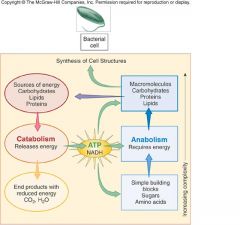![]()
![]()
![]()
Use LEFT and RIGHT arrow keys to navigate between flashcards;
Use UP and DOWN arrow keys to flip the card;
H to show hint;
A reads text to speech;
23 Cards in this Set
- Front
- Back
- 3rd side (hint)
|
What is metabolism?
|
Gr. metaballein, change.
All chemical reactions and physical workings of the cell. |
|
|
|
What is anabolism?
|
Gr. anabole, a throwing up.
Any process that results in synthesis of cell molecules and structures. (somestimes referred to as biosynthesis) |
|
|
|
What is catabolism?
|
Gr. katabole, a throwing down.
The chemical break down of complex compunds into simpler units to be used in cell metabolism. |
Think catastrophy.
|
|
|
What functions does metabolism form?
|
1. degrades macromolecules into smaller molecules and release energy.
2. energy that is released is converted into ATP or released as heat; and 3. the smaller molecules are assembled to form larger macromolecules specific to the cell and in this process ATP is utilized to form bonds. |
|
|
|
What is an enzyme?
|
Gr. en, in, and syme, leaven. Named for catalytic agents first found in yeasts.
Biological catalysts that increase the rate of a chemical reaction by lowering the energy of activation. The enzyme is not permanently altered in the reaction. Enzyme promotes a reaction by serving as a physical site for specific substrate molecules to position. |
Does NOT create a reaction
|
|
|
What is a catalyst?
|
Gr. katalysis, dissolution.
A substance that alters the rate of a reaction without being comsumed or permanently changed by it. In cells, enzymes are catalysts. |
|
|
|
What is the energy of activation?
|
The minimum energy input necessary for reactants to form products in chemical reactions.
|
|
|
|
What is a substrate?
|
The specific molecule upone which an enzyme acts.
|
|
|
|
What is holoenzyme?
|
Gr. holos, whole.
A combination of a protein and one or more cofactors. |
Also known as a conjugated enzyme.
|
|
|
What are cofactors?
|
An enzyme accessory. It can be organic, such as coenzymes, or inorganic, such as Fe , Mn , Zn ions.
|
|
|
|
What are apoenzymes?
|
The protein part of an enzyme, as opposed to the nonprotein or inorganic cofactors.
|
|
|
|
What is an active site?
|
The site where the substrate binds
|
It's a crevice or groove. Also known as a catalytic site.
|
|
|
What is a coenzyme?
|
Organic compounds that work in conjuctions witht he an apoenzyme to perform a necessary alteration of a substrate.
FUNCTION: remove a functional group from one substrate molecule and add it to another substrate, thereby serving as a transient carrier of this group. |
|
|
|
What is an exoenzyme?
|
Enzymes that transport extracellularly, where they break down large food molecules or harmful chemicals
|
Examples include: cellulase, amylase, penicillinase
Exo - exit cell |
|
|
What is an endoenzyme?
|
enzymes retained intracellularly and function there
|
Endo - inside cell
|
|
|
Describe the model of metabolism.
|

Cellular reactiosn fall into 2 major categories: 1) Catabolism involves the breakdown of complex organic molecules to extract energy and form simpler end products; 2)Anabolism uses the energy to synthesize necessary macromolecules and cell structures from simple precursors. These processes are interactive and complementary, thereby maintaining chemical and energy balance.
|
|
|
|
What is conjugated enzyme structure?
|

All have an apoenzyme (polypeptide or protein) component and one or more cofactors.
|
|
|
|
Describe enzyme-substrate reactions.
|

a) When the enzyme and substarte comet together, the substrate (s) must show the correct fit and position with respect to the enzyme (e).
b)When the es complex is formed, it enters a tranisition state. During this temporary but tight itnerlocking union, the enzyme participates directly in breaking or making bonds. c) Once the reaction is complete, the enzyme releases the products. d) The induced fit model proposes that the enzyme recognizes its substrate and adapts slightly to it so that the final binding is even more precise. |
|
|
|
Exoenzymes versus endoenzymes
|

a) Exoenzymes are released outside th cell to function.
b) Endoenzymes remain in the cell and function there. |
|
|
|
Describe the difference between competitive vs. noncompetive inhibition
|

Competivitive inhibition other molecules with a structure similar to the normal substarte can occupy the enzyme's active site. Although these molecular mimics have the proper fit for the site, they cannot be further acted upon. The attachment of a mimic effectively prevents an enzyme from attaching to its usual substrate and blocks its activity, output, and possibly the rest of the pathway.
|
|
|
|
Describe the difference between regulated and constitutive enzymes
|

Constitutive enzymes – always present, always produced in equal amounts or at equal rates, regardless of amount of substrate enzymes involved in glucose metabolism
Regulated enzymes – not constantly present; production is turned on (induced) or turned off (repressed) in response to changes in concentration of the substrate |
|
|
|
What is a synthesis or condensation reaction?
|
Synthesis or condensation reactions – anabolic reactions to form covalent bonds between smaller substrate molecules, require ATP, release one molecule of water for each bond formed
|
|
|
|
What is a hydrolysis reaction?
|
Hydrolysis reactions– catabolic reactions that break down substrates into small molecules; requires the input of water to break bonds
|
|

